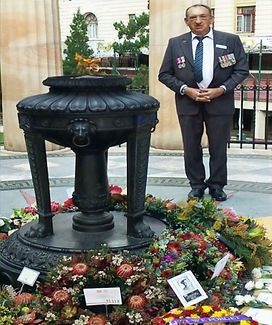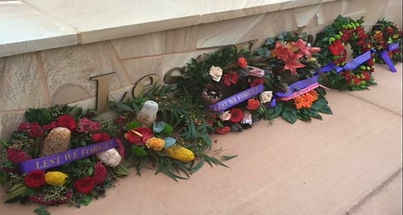OUR NATIONAL SYMBOLS OF REVERANT REMBERENCE
These solemn symbols of remembrance embody the profound respect, unity, and gratitude Australians hold in honouring the sacrifices and enduring legacy of those who served.
The Ode, the Silence, the Eternal Flame, "Lest We Forget," and the Bugle Calls are deeply interwoven into the very essence of Australian society and the nation's identity.
THE SACRED SYMBOLS
THE ETERNAL FLAME
The Eternal Flame is a powerful symbol of remembrance and respect, deeply rooted in commemorative traditions. Its origin can be traced back to ancient practices, where flames represented eternal life and the enduring spirit of those who had passed. In the context of modern remembrance, the Eternal Flame signifies the everlasting gratitude and memory of those who served and sacrificed in wars.
In Australia, the Eternal Flame is prominently featured in war memorials and commemorative sites, such as the Shrine of Remembrance in Anzac Square, Brisbane. It was lit during the dedication ceremony of Anzac Square on September 11, 1930 and burns continuously, serving as a poignant reminder of the courage and dedication of service members. The flame's unending light symbolizes the enduring legacy of their sacrifices and the commitment to peace and freedom.
The Eternal Flame is not just a physical presence; it is a profound representation of national identity and collective memory. It invites reflection and unity, ensuring that the stories and sacrifices of the past remain alive in the hearts of future generations.



THE ODE

"They shall grow not old, as we that are left grow old"
The Ode, originating from Laurence Binyon's 1914 poem "For the Fallen," has become a profound symbol of reflection and unity in Australian culture. The fourth stanza of the poem, famously beginning with "They shall grow not old, as we that are left grow old," is recited during Anzac Day and Remembrance Day ceremonies as a tribute to the courage and sacrifice of those who served and died in wars.
This tradition is often accompanied by the phrase "Lest we forget," which transcends its ceremonial context to serve as a broader reminder of the importance of remembering sacrifices made for freedom and peace. Its recitation, followed by a moment of silence, fosters gratitude, reflection, and a sense of national identity.
Beyond the formalities, The Ode has inspired art, literature, and public discourse, serving as a lasting symbol of resilience and respect. Its poignant message resonates not only in ceremonies but also in schools, community gatherings, and daily conversations, emphasising the enduring legacy of service and sacrifice.
LEST WE FORGET
The phrase "Lest we forget" holds profound significance in Australian commemorative traditions. Its origin can be traced back to Rudyard Kipling's 1897 poem "Recessional," where it served as a solemn reminder of the dangers of pride and the importance of remembering sacrifices made for peace and freedom.
In Australia, "Lest we forget" has become a cornerstone of remembrance ceremonies, particularly on Anzac Day and Remembrance Day. It is often recited alongside The Ode and followed by a moment of silence, creating a poignant atmosphere of reflection and unity. The phrase transcends its literary roots to symbolize collective memory and gratitude for those who served and sacrificed in wars.
This enduring expression resonates deeply in Australian culture, reminding generations of the importance of honoring the past while striving for a peaceful future. Its presence in ceremonies, memorials, and everyday conversations underscores its role as a powerful emblem of national identity and respect.

THE SILENCE

The tradition of observing a moment of silence holds deep significance in commemorative practices, particularly in Australia. Its origins can be traced back to World War I, when King George V issued a proclamation in 1919 calling for a two-minute silence to honor those who had sacrificed their lives in the war. This solemn pause was first observed on Armistice Day, marking the end of the war on November 11, 1918.
In Australia, the moment of silence has become an integral part of ceremonies such as Anzac Day and Remembrance Day. It serves as a powerful act of collective remembrance, allowing individuals to reflect on the courage and sacrifice of those who served in the armed forces. The silence is often preceded by The Ode and followed by the haunting notes of "The Last Post," creating a poignant atmosphere of respect and unity. In 1997, our Governor-General issued a proclamation recommending that The Silence be for one minute, which is what we observe today.
This observance transcends generations, reminding Australians of the enduring legacy of service and the importance of peace. It is a time to pause, reflect, and express gratitude for the freedoms secured through immense sacrifice. The moment of silence continues to be a cornerstone of national identity and remembrance.
BUGLE CALLS - LAST POST & REVEILLE
The Last Post and Reveille are two iconic bugle calls that hold deep significance in military and commemorative traditions. Their origins and meanings are steeped in history, symbolizing the cycle of duty and remembrance.
The Last Post, dating back to the 17th century, was originally part of a British Army routine known as "tattoo," marking the end of a soldier's day. Over time, it evolved into a solemn farewell, played at military funerals and memorial services to honor those who have fallen. In Australia, it is a central feature of Anzac Day and Remembrance Day ceremonies, symbolizing the end of a soldier's life and their final rest.
Reveille, on the other hand, is a bright and cheerful call that signals the start of a soldier's day. Historically used to rouse soldiers from sleep, it has also been incorporated into funeral and remembrance services. Reveille symbolizes an awakening in a better world for the dead and a call to the living to return to their duties after paying respects.
Together, these bugle calls create a poignant narrative of reflection and renewal. The Last Post honors the sacrifices of the past, while Reveille inspires hope and commitment to the future. Their enduring presence in ceremonies ensures that the legacy of service and sacrifice remains alive in the hearts of Australians.

